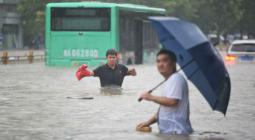Current heatwave across US south made five times more likely by climate crisis

The record heatwave roiling parts of Texas, Louisiana and Mexico was made at least five times more likely due to human-caused climate change, scientists have found, marking the latest in a series of recent extreme “heat dome” events that have scorched various parts of the world.
A stubborn ridge of high pressure has settled over Mexico and a broad swath of the southern US over the past three weeks, pushing the heat index, a combination of temperature and humidity, to above 48C (120F) in some places.
More than 40 million people in the US, including those living in the Texas cities of Houston, San Antonio and Austin, have been placed under excessive heat warnings, raising fears over the health of people vulnerable to the heat and placing Texas’s energy grid under strain from surging air conditioner use.
The heating of the Earth’s atmosphere and oceans by the burning of fossil fuels made the extreme heatwave at least five times more likely, according to a recent analysis by Climate Central, a climate science non-profit. The punishing heat, which is forecast to linger further throughout the week in Texas, is creating “stressful conditions for millions of people”, according to Andrew Pershing, vice-president for science at Climate Central.
Speaking to the Guardian on Monday, Andrew Dessler, a climate scientist at Texas A&M University said the university’s campus at College Station has had a string of days above 37C (100F), when it usually doesn’t hit such peaks until August. “It’s depressing to think we’re not even in July and we are getting this sort of heat,” he said. “When it’s this hot you are a prisoner in your own house, you are a prisoner to air conditioning.”
Dessler said that the southern part of Texas will probably have one of its hottest Junes ever recorded as it is most acutely affected by the heat dome that has its epicenter in Mexico – the Mexican cities of Monclova and Chihuahua have set all-time record temperatures of of 46C (115F) and 41C (107F), respectively.
This heat dome, one the strongest ever recorded, was formed by a high-pressure atmospheric system that created a sinking column of warming air that trapped latent heat already absorbed by the landscape, like a sort of lid. Such events typically occur without rain and are cloudless, allowing the sun to bake the surface unhindered, causing temperatures to spike.
“The heat evaporates water and then just heats up the land,” said Dessler. “If you have this sort of high-pressure system sitting stationary over a region, you can have these really impressive heatwaves.”
Heat domes have long existed in Texas, and elsewhere, and there is some conjecture among scientists as to whether or not the climate crisis is causing more “blocking events” where patches of high pressure are held in place by alterations to a jet stream that normally pushes weather systems from west to east.
More than 40 million people in the US, including those living in the Texas cities of Houston, San Antonio and Austin, have been placed under excessive heat warnings, raising fears over the health of people vulnerable to the heat and placing Texas’s energy grid under strain from surging air conditioner use.
The heating of the Earth’s atmosphere and oceans by the burning of fossil fuels made the extreme heatwave at least five times more likely, according to a recent analysis by Climate Central, a climate science non-profit. The punishing heat, which is forecast to linger further throughout the week in Texas, is creating “stressful conditions for millions of people”, according to Andrew Pershing, vice-president for science at Climate Central.
Speaking to the Guardian on Monday, Andrew Dessler, a climate scientist at Texas A&M University said the university’s campus at College Station has had a string of days above 37C (100F), when it usually doesn’t hit such peaks until August. “It’s depressing to think we’re not even in July and we are getting this sort of heat,” he said. “When it’s this hot you are a prisoner in your own house, you are a prisoner to air conditioning.”
Dessler said that the southern part of Texas will probably have one of its hottest Junes ever recorded as it is most acutely affected by the heat dome that has its epicenter in Mexico – the Mexican cities of Monclova and Chihuahua have set all-time record temperatures of of 46C (115F) and 41C (107F), respectively.
This heat dome, one the strongest ever recorded, was formed by a high-pressure atmospheric system that created a sinking column of warming air that trapped latent heat already absorbed by the landscape, like a sort of lid. Such events typically occur without rain and are cloudless, allowing the sun to bake the surface unhindered, causing temperatures to spike.
“The heat evaporates water and then just heats up the land,” said Dessler. “If you have this sort of high-pressure system sitting stationary over a region, you can have these really impressive heatwaves.”
Heat domes have long existed in Texas, and elsewhere, and there is some conjecture among scientists as to whether or not the climate crisis is causing more “blocking events” where patches of high pressure are held in place by alterations to a jet stream that normally pushes weather systems from west to east.The record warm winter experienced by many countries in Europe earlier this year, as well as a separate heatwave that scorched the continent last summer and resulted in thousands of deaths, have also been blamed, in part, upon heat domes that refused to budge.
One of the harshest heat domes on record settled over the US north-west, a place used to more temperate climes, in the summer of 2021, causing temperature records to be shattered and dozens of people to die. Last week, Oregon’s most populous county sued major oil and gas companies for billions of dollars in damages for their role in fueling the heatwave.
Scientists have calculated that the climate crisis made that heatwave 150 times more likely, with heat domes becoming ever more dangerous as the planet heats up. Limiting global heating to 1.5C (2.7F) above pre-industrial times, instead of 2C (3.6F), would halve the number of people exposed to the sort of severe heat dome conditions that caused such distress in 2021, a study has found.
Local authorities can help counter heat domes by setting up cooling centers and providing warnings and shelter to those most affected by the heat, such as the sick and the elderly, but scientists say the global heating already set in motion by the untrammeled combustion of oil, coal and gas will continue to have escalating impacts.
“It’s clear that we are way outside natural variability here,” said Wehner. “Dangerous climate change is here, now. If you don’t recognize that, you’re just not paying attention. Every summer now there’s some devastating heatwave somewhere in the world.”
cover photo:A temperature display reading 99F (about 37.2C) in late afternoon in Houston, Texas, at the weekend. Photograph: Xinhua/Shutterstock




